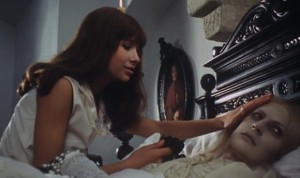STUDIO: Criterion | DIRECTOR: Jaromil Jires | CAST: Jaroslava Schallerova, Helena Anyzova, Petr Kopriva, Jiri Prymek, Jan Klusak
RELEASE DATE: 6/30/15 | PRICE: DVD $29.95, Blu-ray $39.95
BONUSES: Three early shorts by Jaromil Jires, new interview with historian Peter Hames, interviews with cast members, alternate soundtrack by the Valerie Project
SPECS: NR | 76 min. | Foreign language fantasy | 1.37:1 widescreen | Czech with English subtitles
In a supplement included in this deluxe Criterion edition of the 1970 Czech cult movie Valerie and Her Week of Wonders, film historian Peter Hames says that it’s “difficult to know whether you should say this is a horror film, this is a fantasy film, this is a soft porn film, this is an art film, because it’s not really any of those things and, in some ways, it’s all of those things.” To clarify matters, he also emphasizes that you may well “end up completely puzzled” while watching Valerie.
That, of course, is only if your primary goal is to “figure out” what’s going on and fit the film’s events into a linear, conventional storyline. If, as Hames stresses, you are able to experience it simply as a “flow of images” that is both visually overpowering and loaded with potent symbols of curiosity, fear and sexuality, you are most certainly in for a wild ride.
The plot, such as it is, concerns Valerie (Jaroslava Schallerova), a 13-year-old who lives with her grandmother. While Valerie is pursued by a horny holy man (Jan Klusak), her grandmother regains her youth through oddly vampiric means and, later on, Valerie’s missing parents reappear. All through her adventures, the teen keeps reassuring herself “this is only a dream…”
Valerie is most clearly a modernist take on fairy tales that is also an allegory for several things, most particularly a young girl’s discovery of sex during puberty. Director Jaromil Jires (The Joke, found in the Pearls of the Czech New Wave box set from Eclipse/Criterion) and his co-screenwriter Ester Krumbachova (Daisies, also found in the Pearls box) fashion an hallucinogenic variation on Alice in Wonderland that includes supernatural elements (like magic earrings that are stolen from Valerie, a clear symbol of her virginity) and characters whose identities are intentionally blurred, as with a suitor who may or may not be Valerie’s brother.
 A print essay by Jana Prikryl provides details of the film’s production and spells out its important status as the last work of the Czech New Wave. Like many of the best works in that movement, it was banned in Czechoslovakia and acquired a following in other European countries and the U.S. before it was seen in the land in which it was made.
A print essay by Jana Prikryl provides details of the film’s production and spells out its important status as the last work of the Czech New Wave. Like many of the best works in that movement, it was banned in Czechoslovakia and acquired a following in other European countries and the U.S. before it was seen in the land in which it was made.
As it stands, the film is simultaneously mesmerizing and bewildering, but it retains its power to sweep viewers with its lush visuals. It is also impressive that Jires and Krumbachova did not cut corners with the always controversial issue of teenage sexuality (Schallerova was indeed 13 when the film began production). Perhaps the fact that it — like most of the Czech New Wave films — functions as an allegory has kept it fresh over the last 45 years, whereas many adaptations of Lewis Carroll’s most famous work are viewed as quaint relics of the periods in which they were made.
Interviews with two of the film’s stars illustrate how different participants (of different age groups) can view a film shoot. Star Schallerova looks back fondly on her film debut, noting that the only downside was the sequence in which Valerie is burnt at the stake (she survives this — it’s a long story).
Jan Klusak (A Report on the Party and Guests, also in the Pearls box), who played the “perverse friar” (his description of his character), says that Valerie “ranks among my worst memories.” He recounts the many ways in which he was tormented by the crew, including them keeping him hanging in a noose apparatus for quite some time after the sequence in question had been shot. He also notes that the film’s shoot took much longer than was originally planned due to bad weather.
The three early shorts by Jires included in this package demonstrate the range of material that interested him as a young filmmaker. The first is a charming vignette in which a burglar breaks into a house through the window in a child’s bedroom, and then has to entertain the child to keep him from making noise. Counterpointing this is the third short, a stylish, deadly serious docudrama which begins with images of the Holocaust and hinges on the dropping of a nuclear bomb.
The most unusual supplement is an alternate musical soundtrack created by a musical ensemble calling itself “the Valerie Project.” The two men who devised the project explain in on-camera interviews that the music was written and rehearsed by the participants, with a modest amount of improvisation allowed in each of the live performances of the new score, which runs the length of the whole film.
The music is quite fascinating, lending a folk/psychedelic/neo-classical sound to the picture. The principal musician emphasizes that the ensemble didn’t wish for their score to supersede the original, very impressive one by Czech composer Lubos Fiser. From all accounts the live performances of the score (which took place in several cities) were unique sensory experiences, but it is recommended that home viewers watch the film with its original soundtrack first and then explore the Valerie Project’s score after that, if one cares to.
|
Buy or Rent Valerie and Her Week of Wonders
|
|||
|---|---|---|---|
 |
|||
Leave a Reply